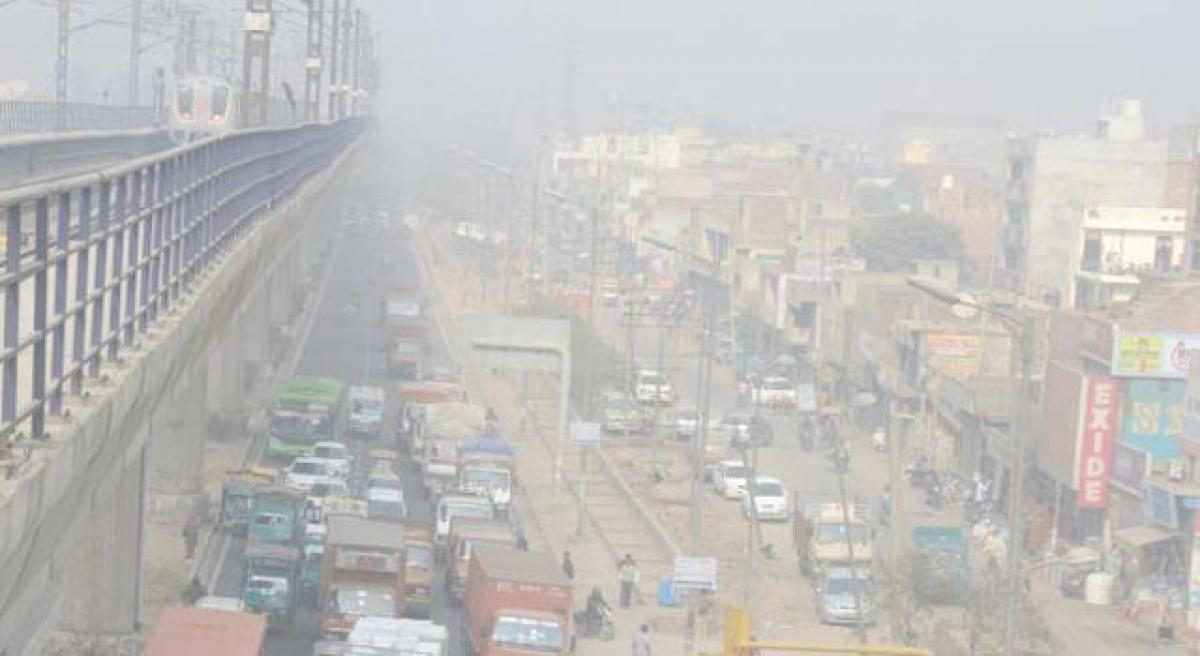Live
- Edu institutions to receive fee reimbursement soon
- SP orders speedy disposal of PGRS petitions
- 11 get placement after completing CPBFI
- Balineni dares Chevireddy for an open debate
- SRM hosts IRIS-2024 summit
- Make AP solar hub: CM
- Pakistan Protests: PTI Supporters March Towards Islamabad, Demanding Imran Khan's Release
- Additional Collector Conducts Surprise Visit to Boys' Hostel in Wanaparthy
- Punjab hikes maximum state-agreed price for sugarcane, highest in country
- Centre okays PAN 2.0 project worth Rs 1,435 crore to transform taxpayer registration
Just In

Delhi’s air is the worst among world megacities, the World Health Organisation (WHO) confirmed recently, even as IndiaSpend‘s #breathe network of air-quality sensors reported fine-particulate-matter (PM2.5) levels were almost four times above daily safe levels, on average, for the seven-day period from September 22 to 28, 2016.
Delhi’s air is the worst among world megacities, the World Health Organisation (WHO) confirmed recently, even as IndiaSpend‘s #breathe network of air-quality sensors reported fine-particulate-matter (PM2.5) levels were almost four times above daily safe levels, on average, for the seven-day period from September 22 to 28, 2016.
For long-term exposure, these 24-hour levels are nearly 11 times above the WHO health standards. Over the monsoon, Delhi's air was relatively cleaner because the rain and wind diminished the impact of pollutants. But with the season changing, three of our five sensors in the National Capital Region (NCR) registered "poor" to "very poor" air-quality levels from September 22 to 28, meaning prolonged exposure affects healthy people and "seriously impacts" those with existing disease.
In December 2015, week-long analysis of data from #breathe devices showed Delhi's air pollution was one-and-a-half times worse than in Beijing, IndiaSpend reported. In 2012, with one million deaths, China reported the highest toll from PM2.5 and PM10 pollution. At the time, India followed, reporting 621,138 deaths, nearly 10 per cent of the global toll (6.5 million deaths) associated with outdoor and indoor air pollution.
However, between 2011 and 2015, in a comparison of megacities with population above 14 million, Delhi's ambient air-pollution levels were worse than Beijing and Shanghai, an IndiaSpend analysis of the WHO's 2016 data of global ambient air pollution showed. Delhi recorded a PM10 level of 229 mg/m³, followed by Cairo with 179 mg/m³ and Dhaka with 158 mg/m³ -- the top three megacities with the most polluted air globally. Beijing and Shanghai were sixth and seventh on that list.
China air-pollution death toll highest in 2012 but Delhi ambient air worse
India's capital was the only megacity to record a PM10 level above 200 mg/m³, exceeding the WHO air quality standard of 20 mg/m³ by more than 900 per cent. Beijing and Shanghai reported ambient air pollution levels of 108 and 84 mg/m³ respectively. Even Kolkata and Mumbai -- recording PM10 levels of 135 mg/m³ and 117 mg/m³ respectively -- had air worse than the biggest Chinese cities.
The WHO guideline for annual mean levels for PM10 is 20 mg/m³ and for PM2.5 is 10 mg/m³. For 24 hours, the levels should not exceed 50 mg/m³ (for PM10) and 25 mg/m³ (for PM2.5). The WHO sourced its data on India's air pollution from the Central Pollution Control Board, Environmental Data Bank.
PM10, or coarse particulate matter with diameter between 2.5 and 10 micrometers, are primarily made up of dirt and dust from farming, factories and roads, and caused due to the crushing of rocks and soil. Most air-pollution deaths are caused by fine, invisible particles, called PM2.5, about 30 times finer than a human hair.
These pollutants, if inhaled deep into the lungs, can cause heart attacks, strokes, lung cancer and respiratory diseases, and are known to pose the greatest risk to human beings. Their measurement is considered to be the best indicator of the level of health risks from air pollution, according to the WHO.
Gwalior, Allahabad report worst levels
Within India, the smaller cities of Gwalior and Allahabad measured the worst levels of ambient air pollution at PM2.5 levels of 176 mg/m³ and 170 mg/m³ respectively. A significant portion of northern India falls in a zone with "critical" air pollution-reporting PM2.5 levels of over 70 mg/m³ in the WHO's mapping of air pollution and population.
The WHO's new air-quality model, it's most comprehensive yet, is based on information from satellite measurements, air-transport models and ground-station monitors for more than 3,000 urban and rural areas across the world. It analyses this with population data in a grid pattern area of 10 sq km. It was developed by the WHO in collaboration with the University of Bath and confirms that 92 per cent of the world's population lives in places where air quality levels exceed WHO limits.
11,297 persons per sq km at risk
Up to 97.5 per cent of Delhi's 16.8 million people live in urban areas, and the city has a density of 11,297 persons per sq km-making it one of the densest regions in the country -- according to Census 2011 data. "Air pollution continues take a toll on the health of the most vulnerable populations - women, children and the older adults," said Dr Flavia Bustreo, Assistant Director General at the WHO.
Some three million deaths every year are linked to exposure to outdoor air pollution, according to the WHO. Nearly 90 per cent of air-pollution-related deaths occur in low- and middle-income countries, with nearly two out of three occurring in WHO's Southeast Asia region (of which India is a part) and the Western Pacific region. Inefficient modes of transport, household fuel and waste burning, coal-fired power plants, and industrial activities are the major sources of air pollution, WHO said.
By arrangement with IndiaSpend.org
By Alison Saldanha

© 2024 Hyderabad Media House Limited/The Hans India. All rights reserved. Powered by hocalwire.com







